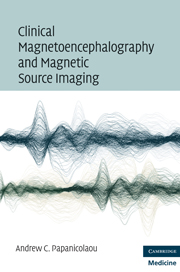Book contents
- Frontmatter
- Contents
- Contributors
- Preface
- Section 1 The method
- Section 2 Spontaneous brain activity
- 11 MEG recordings of spontaneous brain activity – general considerations
- 12 Normal spontaneous MEG – frequently encountered artifacts
- 13 Spontaneous MEG morphology
- 14 Abnormal spontaneous MEG
- 15 Contributions of MEG to the surgical management of epilepsy – general considerations
- 16 MEG investigations in lesional epilepsies
- 17 MEG investigations in nonlesional epilepsies
- 18 Pediatric nonlesional epilepsy surgery
- Section 3 Evoked magnetic fields
- Postscript: Future applications of clinical MEG
- References
- Index
11 - MEG recordings of spontaneous brain activity – general considerations
from Section 2 - Spontaneous brain activity
Published online by Cambridge University Press: 01 March 2010
- Frontmatter
- Contents
- Contributors
- Preface
- Section 1 The method
- Section 2 Spontaneous brain activity
- 11 MEG recordings of spontaneous brain activity – general considerations
- 12 Normal spontaneous MEG – frequently encountered artifacts
- 13 Spontaneous MEG morphology
- 14 Abnormal spontaneous MEG
- 15 Contributions of MEG to the surgical management of epilepsy – general considerations
- 16 MEG investigations in lesional epilepsies
- 17 MEG investigations in nonlesional epilepsies
- 18 Pediatric nonlesional epilepsy surgery
- Section 3 Evoked magnetic fields
- Postscript: Future applications of clinical MEG
- References
- Index
Summary
The practice standards and guidelines for clinical applications of magnetoencephalography were developed by a subcommittee of the International Society for the Advancement of Clinical Magnetoencephalography (ISACM) in 2008. Aspects of these guidelines affecting the recording of spontaneous activity are summarized here.
Head positioning
The procedure for estimating MEG activity sources takes into account the relative distance between the patient's head and the sensors. Therefore, prior to acquiring MEG data, one obtains information about the patient's head position, orientation, and shape by using a 3-D digitizer to register multiple fiducial landmarks (typically the nasion and external meatus of each ear) and points approximating the skull surface. Ideally, the patient is positioned such that the entire head surface is roughly equidistant from the sensors, though in practice positioning can be more flexible. In some cases, especially when a region of interest is known or suspected, such as when a lesion is visible on MRI or lateralized EEG abnormalities are present, standard practice is to adjust the patient's head position to optimize coverage of the previously delimited region of interest. This approach can also be taken for those with larger or smaller head sizes, especially children, to ensure that the region of interest is optimally covered by the sensor array. The patient's head position should be measured before and after each recording block to quantify the degree of movement during acquisition and estimate the quality of the recorded data in the block. For measurements of long duration, particular attention should be paid to the patient's head position to minimize discomfort, and necessary adjustments should be made during breaks between consecutive recording blocks.
- Type
- Chapter
- Information
- Publisher: Cambridge University PressPrint publication year: 2009



